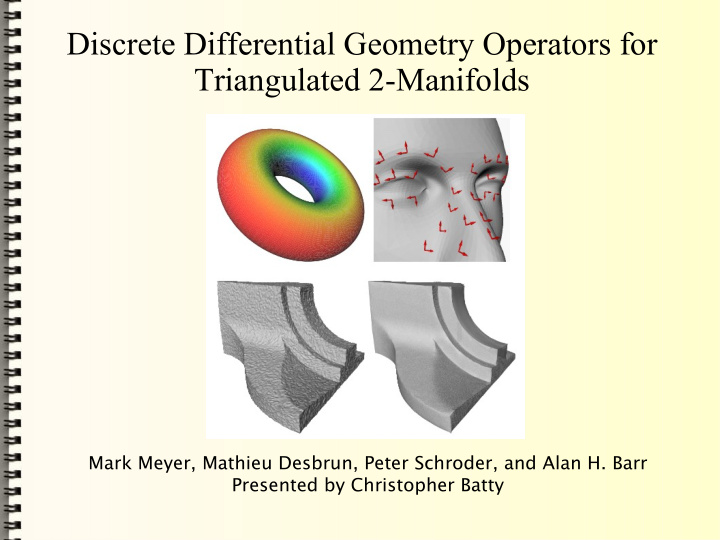



Discrete Differential Geometry Operators for Triangulated 2-Manifolds Mark Meyer, Mathieu Desbrun, Peter Schroder, and Alan H. Barr Presented by Christopher Batty
Basic Premise How can we extend differential geometry to meshes? Goal – Consistent operators for first and second order differential properties: ● Normal ● Curvatures (Mean, Gaussian, Principal), ● Principal Directions We've already looked at a couple of approaches.
Why? Numerous mesh-processing applications: ● Mesh smoothing/enhancement ● Re-meshing ● Parameterization ● Subdivision ● Simplification ● Etc. Also, applications in higher dimensions : ● Denoising of data
Approach Take properties at vertices to be spatial average of a local region of the mesh (integrate), as seen in class. Choose regions carefully to ensure maximum accuracy. Derive expressions for differential operators that respect the same properties as continuous counterparts.
Choosing Regions Split edges at midpoints. How to join midpoints? Either connect to: circumcenter barycenter (avg vertices).
Mean Curvature Normal Given a point P, the mean curvature normal (AKA Laplace-Beltrami) operator is: Gives both the mean curvature and unit normal at the vertex.
Mean Curvature Normal For a triangle mesh, parameterized by u,v, along edges, over a region M, this is a Laplacian: where:
Gauss' Theorem Gauss' theorem lets us convert an area integral into a line integral around the boundary. Since our mesh is piece-wise linear, the gradient of x is a constant over each triangle.
Mean Curvature Normal Because the gradient is constant, our choice of region will not affect the integral's value. Thus we can simply use a straight line. For the integral in one triangle we then have:
Mean Curvature Normal Now, note that any point in the triangle is a linear combination of its vertices. Taking the gradient gives:
Mean Curvature Normal The gradient of the B's are perpendicular to the opposing edge and sum to 0, so rearranging: Applying this to the earlier integral gives: Now, the dot product is proportional to a cosine, and the A T term is proportional to a sine, so...
Mean Curvature Normal Replace with a cotangent ( = cos/sin) to get:
Mean Curvature Normal And finally... So what have we done exactly? Derived a simple expression for mean curvature normal depending only on vertex positions and angles of the adjacent triangles.
Error Analysis Consider a C 2 surface, tiled with our triangulated C 0 surface. We can express the error between our spatial average and the correct pointwise average as: If C i is the Lipschitz constant for K(x), then:
Error Analysis Taking the C i 's outside the summation: Recall that Voronoi regions minimize ||x-x i || by definition. Assuming C varies with ratio ε from patch to patch, we are guaranteed that the Voronoi region is no more than O( ε) from the true optimal patch.
But... This is only valid for non-obtuse triangles. For obtuse triangles the circumcenter will lie outside of the triangle. Work-around: U se the midpoint of the edge opposite to the obtuse angle as the center. Gives a non-overlapping tiling of the surface using Voronoi cells where possible.
Obtuse Triangles Example of mixed areas around a vertex: Area of non-Voronoi regions is either A triangle /2 or A triangle /4:
Summary So Far Area computation: Mean curvature normal operator:
Gaussian Curvature Easy! We looked at it in class already – use the Gauss-Bonnet theorem (but with new region definition). Gaussian Curvature operator:
Principal Curvatures We now have both the mean and Gaussian curvatures, and we know the relationships: We can rearrange and solve. Principal Curvature operators:
Curvature Visualization
Principal Directions Before I get into (more) math, here's the overview: Mean curvature formula can be seen as a weighted sum of normal curvatures along adjacent edges. Use these samples of curvature normals to fit an ellipse with least squares, to determine a curvature tensor. Extract eigenvectors from this tensor – these are the principal directions.
Mean Curvature, Interpreted Where: This an expression for curvature along an edge.
Interpretation Right angle implies: Rearranged: which is the inverse of what we just saw: Hence each K N i,j is an estimate of curvature along an edge.
So? So, our mean curvature formula can be interpreted as weighted combination of normal curvature samples along neighbouring edges. Let's fit an ellipse to these curvature samples to find a least-squares approximation of the curvature tensor.
Curvature Tensor The (symmetric) curvature tensor looks like: Applied to a tangent vector, it should give the curvature normal along that direction. We just project each edge onto the tangent plane to get d i,j 's.
Curvature Tensor Apply least squares minimization to the error to get B. Extract the eigenvectors from B, and voila! It is just that easy.
Numerical Results Accuracy roughly equivalent to finite differences, without the restriction of regular meshes. Compared against analytical surfaces at varying resolutions: ● Less than 1.3% error for Gaussian curvature ● Less than 0.07% error for mean curvature Irregular sampling reduces accuracy, but “in practice, the rate at which the error increases is low.”
Applications
Conclusions Is this approach an improvement? Gives a more convincing justification for choice of both surface normal and the region type used for calculations. Better numerical results than existing approaches. Graceful degradation in the presence of irregular meshes (claimed).
References M. Meyer, M. Desbrun, P. Schröder, and A. H. Barr, "Discrete differential geometry operators for triangulated 2-manifolds," in VisMath, 2002. http://www.wikipedia.org http://mathworld.wolfram.com/
Recommend
More recommend